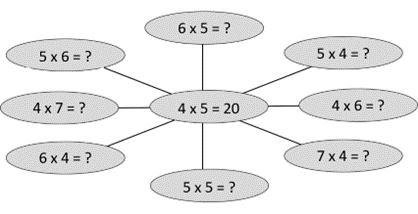Purpose
The purpose of this activity is to support students deriving from simple multiplication facts related to simple skip counting patterns: twos, fives, and tens.
Achievement Objectives
NA2-1: Use simple additive strategies with whole numbers and fractions.
Required Resource Materials
- Counters
- Saucers or plastic lids (icecream , yoghurt or similar)
Activity
- Write this problem on the board. (Note this context could be adapted to better reflect your students' interests, cultural backgrounds, and learning from other curriculum areas).
I have four plates. I want to put ten cookies on each plate to serve my guests.
How many cookies will I need?
- Lay out four "plates" and let students help by putting ten counters (pretend cookies) on each plate.
- Let the students work in pairs to find out how many cookies there are in total, and then present this learning using their preferred method (e.g. skip counting, multiplication expression, verbal description of the diagram). You might record a lsit of the different strategies used for students to see.
- Look for students to use their place value knowledge of "four tens equal forty". If needed, introduce the “ty” code with examples like “six tens equal sixty.”

- Ask: How can I write this problem using multiplication?
Look for students to suggest using multiplication, 4 x 10 = 40. If needed, tell students that this strategy can be used.
- Discuss the meaning of 4 x 10 = 40
What do 4 and 10 represent in this story? (The multiplier, 4, is the number of plates and the multiplicand, 10, is the number of cookies per plate.)
Use a calculator to confirm the equation.
- Starting from 4 x 10 = 40, propose variations to the story so that students can derive the new answer from the previous one.
- I don’t think four plates is enough. I need six plates. How many cookies is that in total?
What do we need to change?
The multiplication was 4 x 10 = 40. What is it now?
What is the product? (answer)
Write 4 x 10 = 40 so 6 x 10 = 60.
- I don’t think six plates of ten cookies each will be enough either. I need 11 cookies on each plate.
What do we need to change?
The multiplication was 6 x 10 = 60. What is it now? (6 x 11)
What is the product? (answer)
Write 6 x 10 = 60 so 6 x 11 = 66.
- Another group of guests is coming. I need 7 plates now.
What do we need to change?
The multiplication was 6 x 11 = 66. What is it now? (7 x 11)
What is the product? (answer)
Write 6 x 11 = 66 so 7 x 11 = 77.
- I don’t think four plates is enough. I need six plates. How many cookies is that in total?
- Create other sequences like this, starting with a multiplicand of two or five. Good examples might be:
- I have six plates. I want to put two cookies on each plate to serve my guests. How many cookies will I need?
That looks a bit stingy. I want to put three cookies on each plate to serve my guests. How many cookies will I need altogether now?
I don’t think six plates of three cookies each will be enough either. I need seven plates of three cookies each.
Three cookies per plate still looks stingy. I want four cookies on all seven plates. - I have five plates. I want to put five cookies on each plate to serve my guests. How many cookies will I need?
Five plates are not enough. I need six plates of five cookies on each plate.
Five cookies per plate won’t cut it. I need six cookies on all six plates.
I think I will need seven plates with six cookies on each plate.
- I have six plates. I want to put two cookies on each plate to serve my guests. How many cookies will I need?
- Record the equations in sequence to see if students can translate between the symbols and the plate situations. For example:
4 x 10 = 40 so 6 x 10 = 60 so 6 x 11 = 66 so 7 x11 = 77
Supporting questions might be:
What changed to make 4 x 10 into 6 x 10?
What changed to make 6 x 10 into 6 x 11?
- Invite students to begin with their own multiple of two, five, or ten and come up with a sequence of equations. They might use saucers and counters to represent the equations, or draw diagrams of the situation. Consider what groupings will be most appropriate for students, and what will best encourage peer scaffolding, extension, and productive learning conversations.
Look for students to fold back to the given materials and context to illustrate the changes between one equation and the other.
Next steps
- Continue to increase students’ repertoire of known multiplication facts. Use the opportunity of derived facts to add to the fact cards on the maths wall. For example, 6 x 6 = 36 is derived from 6 x 5 = 30.
- Create spider webs of ‘new facts’ that can be found by deriving from a single multiplication fact. An example might be:

Add to plan
Level Two